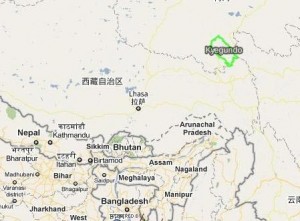 Hundreds have been killed in the Tibetan area of Yushu, Kham (Tibetan: Kyigundo, also known as Jyekundo) in present-day Qinghai, when a series of strong earthquakes measured at magnitude 6.9 hit the region this morning. Reports in the state media say that at least 400 people have been killed and thousands of others injured, and it is not known how many are still buried in the rubble. Aid workers in contact with the region, which is in the eastern Tibetan area of Kham, say that the death toll is certain to rise, with one official saying that in the last few hours it has exceeded a thousand, although this is currently impossible to confirm.
Hundreds have been killed in the Tibetan area of Yushu, Kham (Tibetan: Kyigundo, also known as Jyekundo) in present-day Qinghai, when a series of strong earthquakes measured at magnitude 6.9 hit the region this morning. Reports in the state media say that at least 400 people have been killed and thousands of others injured, and it is not known how many are still buried in the rubble. Aid workers in contact with the region, which is in the eastern Tibetan area of Kham, say that the death toll is certain to rise, with one official saying that in the last few hours it has exceeded a thousand, although this is currently impossible to confirm.
The Dalai Lama sent a message of condolence today, saying: “I am deeply saddened by the loss of life and property as a result of the earthquake that struck Kyigundo [skye rgu mdo] this morning. We pray for those who have lost their lives in this tragedy and their families and others who have been affected. A special prayer service is being held at the main temple (Tsuglagkhang) here at Dharamsala on their behalf. It is my hope that all possible assistance and relief work will reach these people. I am also exploring how I, too, can contribute to these efforts.” (Video message at: www.dalailama.com.)
The epicenter of the earthquakes was a sparsely populated, rural area about 50 km west of Jyeku (Chinese: Jiegu or Gyegu) town, the government seat of Yushu Tibetan Autonomous Prefecture, which is about 800 km south-west of Xining, the provincial capital of Qinghai. The quake was also felt in Kardze (Chinese: Ganzi) in Sichuan, and Chamdo (Chinese: Changdu) in the Tibet Autonomous Region. Images and video are available at: news.xinhuanet.com and twitter.com/limlouisa and www.nytimes.com. (Kyegundo shown map, above, prepared by the blog High Peaks Pure Earth based on resources provided by the Tibetan and Himalayan Library.)
At least 80% of the buildings are said to be flattened in Jyeku, which has a population of at least 100,000 people according to the state news agency Xinhua, including Tibetans and Chinese migrant workers. Local officials said there is no power or water, there are reports that a hospital is damaged, and at least one school has collapsed, trapping its students. Many local people have fled to the mountains, and desperate attempts are ongoing to drain water from a local reservoir where a large fissure appeared in the wall of a hydropower station dam.
A minor earthquake shook the region before 6 am, but a series of powerful quakes then hit from 7.49 am – around the time that parents were dropping their children at school. Xinhua reports that the biggest after-shock was of 6.3 magnitude. Karma Hardy, director of the London-based Tibet Foundation, which has a number of projects in the Yushu area, said that a local official informed him on the phone that the death toll is now nearing 1000.
Although landslides have cut off roads, at least one aid flight has been able to land at Yushu airport today. Local officials say that hundreds of survivors have already been pulled from the rubble and that the military are on the ground carrying out rescue operations. There is a strong military presence in the area, with a base in Yushu township.
Many people are taking rudimentary shelter in makeshift tents. A spokesman for the local government, Zhuo Huaxia, told China’s state news agency Xinhua today: “The streets in Jiegu are thronged with panic – injured people, with many bleeding in the head. Many students are buried under the debris due to building collapse at a vocational school. I can see injured people everywhere. The biggest problem now is that we lack tents, we lack medical equipment, medicine and medical workers.”
Detailed information from the area was difficult to obtain due to telecommunications being cut and damage to local infrastructure. An important monastery in the area, Thrangu, was destroyed by the quakes, with 20 monks being reported as having died, and around 50 injured.
The website High Peaks Pure Earth monitored Tibetan netizens’ responses to the earthquake, reporting that just hours after the earthquake, Tibetans – who appeared to be based mainly in Chinese urban centers – were expressing their grief and anxiety. The most popular blog portal, TibetCul has a black and white banner on its website to commemorate the earthquake (www.highpeakspureearth.com).
ICT has prepared advice for its members who may want to donate money to the various relief efforts underway, and which can be seen here »

